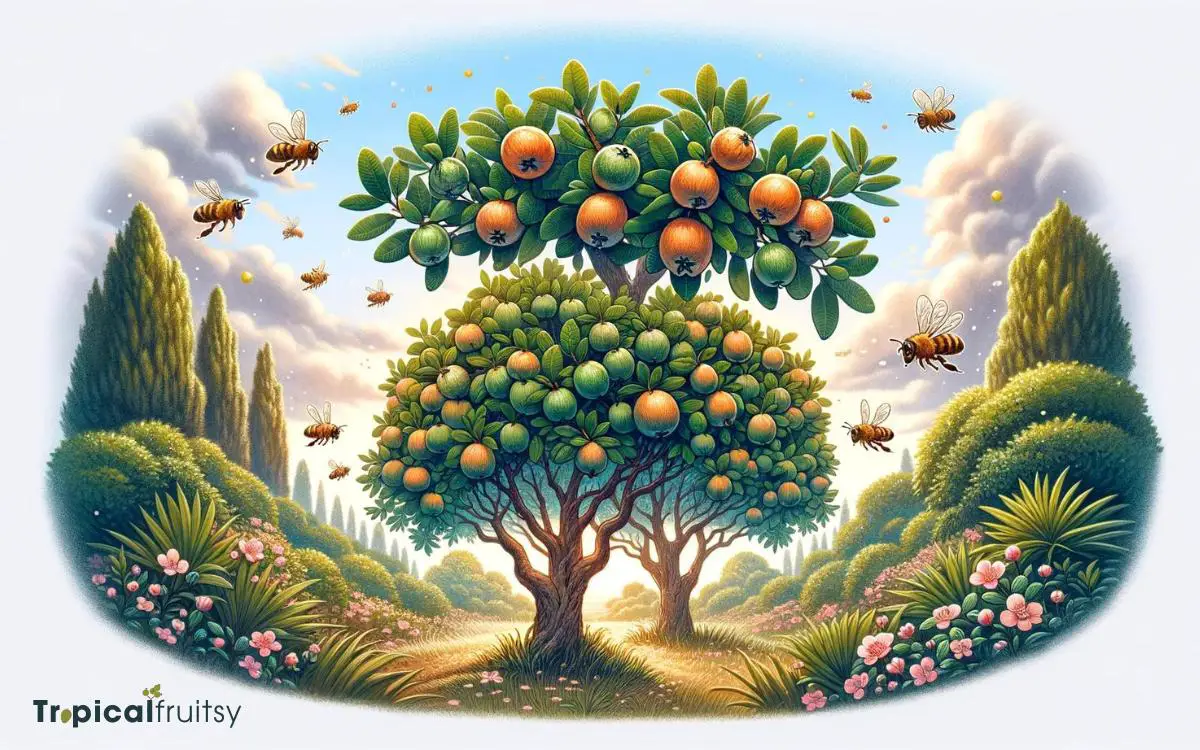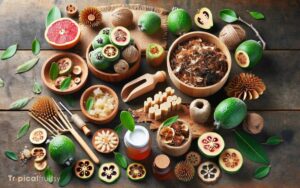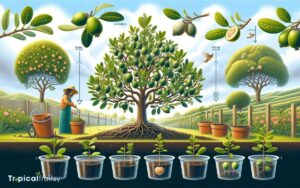Do You Need 2 Feijoa Trees? Yes
Yes, planting two Feijoa trees is recommended for better fruit production. Although some feijoa varieties are self-fertile and can pollinate on their own, having a second tree for cross-pollination generally results in a higher yield and improved fruit quality.
Planting different feijoa varieties close to each other can enhance cross-pollination success.
Feijoa trees, also known as pineapple guava, are unique in their pollination needs. They carry flowers that are capable of self-pollinating, but they perform optimally in the presence of a pollinator variety.
Here are some key points to consider:
- Self-pollination is possible in feijoas, but cross-pollination tends to boost fruit set and quality.
- Having a second tree increases the chances of pollination due to increased flower availability.
- It’s beneficial to plant different varieties of feijoa to ensure cross-pollination.
Boost your feijoa harvest by adding a second tree to your garden, ensuring a diverse and delicious fruit yield.
| Feijoa Variety | Self-fertile? | Recommended Pollinator Variety |
|---|---|---|
| Apollo | Yes | Gemini or another Apollo |
| Gemini | Yes | Apollo or another Gemini |
| Unique | Yes | Another Unique or Apollo |
| Triumph | Partial | Apollo or Gemini |
| Kakapo | Partial | Apollo or Unique |

Key Takeaway
Understanding Feijoa Pollination
To ensure successful fruit set, you’ll need to grasp how feijoa trees are pollinated, as they’re often reliant on cross-pollination from a separate cultivar.
Feijoa (Acca sellowiana), also known as pineapple guava, requires the presence of pollinators, such as birds and bees, to transfer pollen between flowers of genetically distinct plants.
This cross-pollination enhances genetic diversity and typically results in a more robust fruit set.
Feijoa flowers possess both male and female reproductive organs, yet self-pollination is generally insufficient for optimal fruit production.
Therefore, planting two or more different feijoa cultivars in proximity increases the likelihood of successful pollination.
The strategic positioning of these trees allows for easier access for pollinators, facilitating the vital exchange of pollen.
The Role of Cross-Pollination
Why do gardeners often find that having more than one feijoa tree leads to better fruit yields? The answer lies in the role of cross-pollination.
Feijoa trees are technically self-fertile, but they significantly benefit from the presence of another tree for pollination.
Here’s why cross-pollination is crucial:
- Genetic Diversity: It introduces genetic variability, leading to stronger, more resilient plants.
- Pollen Transfer: Insects or wind can transfer pollen more effectively between different trees.
- Fruit Set: Cross-pollinated flowers generally have a higher fruit set and subsequently better yields.
Cross-pollination ensures that the pollen from one tree can fertilize the flowers of another, which is often more efficient than self-pollination.
This process is pivotal for feijoa trees to produce abundant and high-quality fruit.
Single Tree Fruit Set
Feijoas possess a unique attribute that allows for self-pollination, though the rate of fruit set varies significantly among individual trees.
However, researchers have established that cross-pollination typically enhances both the quantity and quality of the fruit produced.
It’s crucial to evaluate the potential benefits of introducing a second feijoa tree to maximize the orchard’s yield.
Self-Pollination Possibility
Although some feijoa varieties can set fruit on their own, the presence of a second tree often enhances pollination and fruit yield. This increased yield results from cross-pollination, which is more effective due to the genetic diversity it introduces. However, a single feijoa tree may still produce fruit through self-pollination under certain conditions.
The potential for self-pollination in feijoas depends on:
- Floral Structure: Feijoa flowers are hermaphroditic, containing both male and female reproductive organs, which allows for the possibility of self-pollination.
- Varietal Characteristics: Some cultivars are known to be self-fertile, meaning they can set fruit without the need for cross-pollination.
- Pollinator Activity: Even self-fertile varieties benefit from pollinators such as birds and bees to transfer pollen within the same flower or between flowers on the same tree.
Cross-Pollination Benefits
One may notice a significant increase in feijoa fruit set and overall quality when cross-pollination occurs, even if a single tree can produce fruit independently.
This phenomenon is attributed to the genetic diversity introduced through the pollen of a different feijoa variety.
The resulting genetic exchange often enhances fruit size, taste, and seed development, which are critical factors for the reproductive success of the plant.
In scientific terms, cross-pollination can maximize heterosis or hybrid vigor, leading to more robust growth and fruit production.
Gardeners and commercial growers alike should consider this when planning their feijoa orchards, as the presence of multiple cultivars can significantly impact the yield and quality of the harvest.
Hence, planting a compatible pollinator nearby is a prudent strategy for optimizing feijoa production.
Benefits of Multiple Trees
Planting multiple feijoa trees can enhance pollination success and yield larger fruit harvests. While a single tree might produce fruit due to self-pollination, the presence of additional trees typically leads to a more abundant crop.
This is because feijoas are partially self-fertile, but they benefit significantly from cross-pollination with neighboring trees.
The benefits of having multiple feijoa trees include:
1. Increased genetic diversity among the fruit, leading to improved disease resistance.
2. A more extended flowering period, which can potentially lengthen the harvesting season.
3. Greater attractiveness to pollinators like bees, enhancing overall pollination rates and fruit set.
Understanding these advantages provides a compelling case for planting more than one tree. Next, we’ll delve into planting and spacing considerations to optimize these benefits.
Planting and Spacing Considerations
When considering the optimal layout for your feijoa trees, adequate spacing is crucial to ensure they thrive and produce a bountiful harvest.
Feijoa trees require sufficient room to accommodate their mature spread, which can be up to 4 meters in diameter.
It’s recommended to plant them at least 2-3 meters apart from one another to facilitate adequate airflow, sunlight penetration, and to allow for proper growth.
This spacing also minimizes the risk of disease by reducing the potential for fungal spores to transfer between crowded branches.
Additionally, when planning your orchard, consider the accessibility for maintenance and harvest. Properly spaced trees are easier to manage and can yield higher quality fruit.
With these considerations in mind, one must also evaluate suitable varieties and pollination partners to further optimize the feijoa orchard’s productivity.
Varieties and Pollination Partners
Understanding the various feijoa varieties and their pollination requirements is essential for a fruitful orchard, as most types benefit from cross-pollination with a compatible partner.
Feijoas, or Acca sellowiana, exhibit varying degrees of self-fertility; however, the presence of a different cultivar enhances fruit set.
Researchers have identified key factors influencing successful pollination:
- Flower structure: Some varieties have flowers better suited for cross-pollination due to their stamen and stigma positions.
- Bloom time: Varieties must flower concurrently to ensure pollen transfer.
- Pollinator activity: Bees and birds are primary pollinators, and their presence is critical.
Selecting varieties that complement each other’s flowering periods maximizes the potential for cross-pollination, thereby improving yield and fruit quality.
Gardeners should consult compatibility charts when choosing feijoa varieties for their orchards.
Maximizing Your Harvest Potential
To optimize feijoa yields, one must understand the significance of pollination partners, as cross-pollination typically enhances fruit set and quality.
Gardeners should plant feijoa trees at strategic distances, which ensures effective pollinator access while avoiding competition for nutrients.
Regular, informed pruning not only maintains tree health but also stimulates higher fruit production, balancing vegetative growth with optimal fruiting.
Pollination Partner Importance
In maximizing your feijoa harvest, it’s crucial to recognize that these plants often require a pollination partner to bear the most fruit.
Feijoas aren’t fully self-fertile and can significantly benefit from cross-pollination, which involves the transfer of pollen from the flower of one plant to the stigma of another.
This genetic exchange enhances fruit set and overall yield.
To ensure effective cross-pollination:
1. Plant at least two feijoa varieties in proximity.
2. Consider the flowering times to ensure they overlap.
3. Encourage pollinator activity by avoiding pesticides and planting pollinator-friendly flora.
Utilizing these strategies increases the likelihood of a bountiful feijoa harvest, as cross-pollination can lead to larger, more numerous, and higher-quality fruits.
Optimal Planting Distance
Planting feijoa trees 1.5 to 5 meters apart maximizes pollination and fruit production. This optimal spacing allows for adequate air circulation, sunlight penetration, and facilitates cross-pollination if different varieties are planted.
Gardeners should consider the mature size of the cultivars selected to avoid overcrowding. Feijoas are self-fertile, but studies have shown that cross-pollinated trees bear larger and more numerous fruits.
The distance also impacts root competition for nutrients and water, where too close spacing can stress the trees and reduce yield.
Strategic placement not only enhances the potential for a bountiful harvest but also minimizes the risk of disease spread among the plants.
With optimal spacing addressed, growers must turn their attention to pruning for productivity, which further influences the health and output of feijoa trees.
Pruning for Productivity
Following optimal spacing, diligent pruning of feijoa trees is essential to maximize fruit yield and maintain tree health.
Pruning not only shapes the tree and encourages new growth but also allows for better air circulation and sunlight penetration, which are critical for fruit development.
The process should be approached with precision and understanding of the tree’s growth patterns.
To streamline the process, consider these key steps:
- Remove dead or diseased wood to prevent the spread of pathogens.
- Thin out dense branches to enhance light exposure to the inner canopy.
- Prune back to outward-facing buds to direct new growth away from the center of the tree.
Executing these steps annually promotes robust health and abundant fruit production in feijoa trees.
Conclusion
While a single feijoa may fruit, fetching a friend fosters a fuller yield. Cross-pollination catalyzes copious crops, and pairing plants with proper pollination partners proves paramount.
Strategic spacing stimulates stronger success, and choosing complementary cultivars can create a cornucopia of flavorsome feijoa.
By banking on biological basics, gardeners can greatly galvanize their grove’s generosity, ensuring an ample, aromatic harvest that’s as delightful to the senses as it’s dense on the branches.






